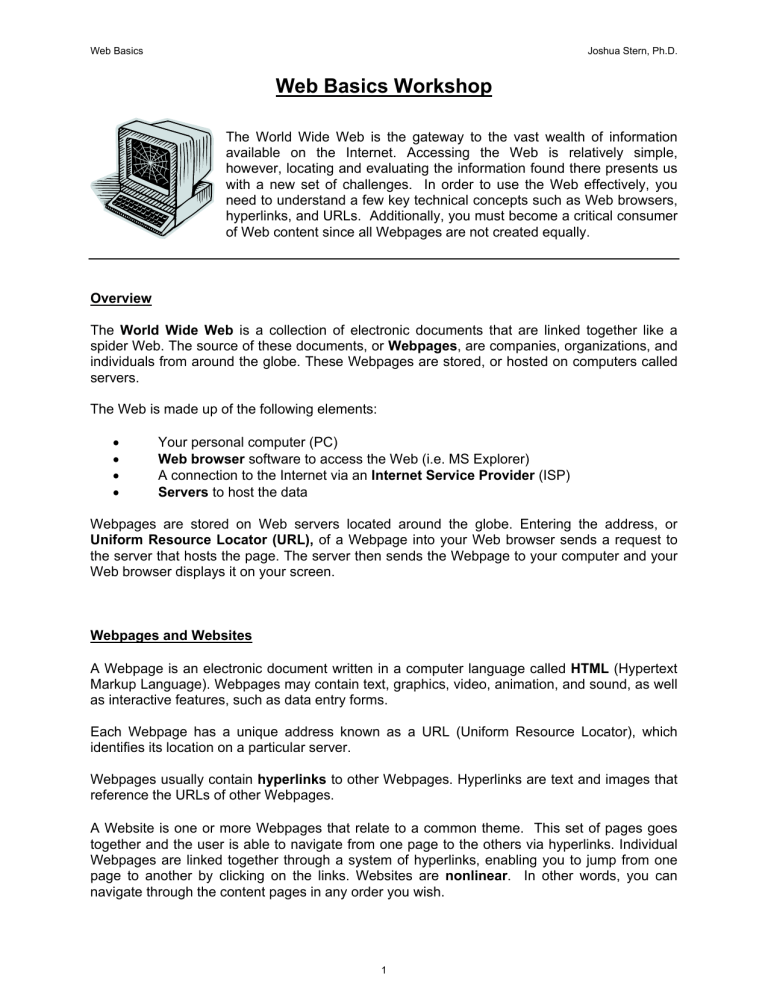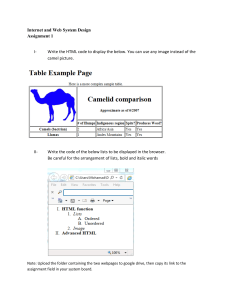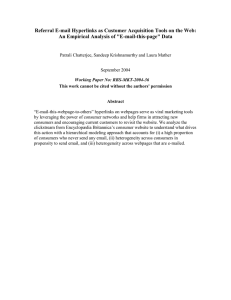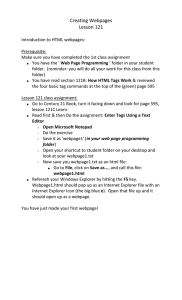
Web Basics Joshua Stern, Ph.D. Web Basics Workshop The World Wide Web is the gateway to the vast wealth of information available on the Internet. Accessing the Web is relatively simple, however, locating and evaluating the information found there presents us with a new set of challenges. In order to use the Web effectively, you need to understand a few key technical concepts such as Web browsers, hyperlinks, and URLs. Additionally, you must become a critical consumer of Web content since all Webpages are not created equally. Overview The World Wide Web is a collection of electronic documents that are linked together like a spider Web. The source of these documents, or Webpages, are companies, organizations, and individuals from around the globe. These Webpages are stored, or hosted on computers called servers. The Web is made up of the following elements: • • • • Your personal computer (PC) Web browser software to access the Web (i.e. MS Explorer) A connection to the Internet via an Internet Service Provider (ISP) Servers to host the data Webpages are stored on Web servers located around the globe. Entering the address, or Uniform Resource Locator (URL), of a Webpage into your Web browser sends a request to the server that hosts the page. The server then sends the Webpage to your computer and your Web browser displays it on your screen. Webpages and Websites A Webpage is an electronic document written in a computer language called HTML (Hypertext Markup Language). Webpages may contain text, graphics, video, animation, and sound, as well as interactive features, such as data entry forms. Each Webpage has a unique address known as a URL (Uniform Resource Locator), which identifies its location on a particular server. Webpages usually contain hyperlinks to other Webpages. Hyperlinks are text and images that reference the URLs of other Webpages. A Website is one or more Webpages that relate to a common theme. This set of pages goes together and the user is able to navigate from one page to the others via hyperlinks. Individual Webpages are linked together through a system of hyperlinks, enabling you to jump from one page to another by clicking on the links. Websites are nonlinear. In other words, you can navigate through the content pages in any order you wish. 1 Web Basics Joshua Stern, Ph.D. The first page of any Website is called the homepage. Think of a homepage as the starting point of a Website. Like the table of contents of a book or magazine, the homepage usually provides an overview of what you'll find at the Website. It acts as an index, often indicating the content of the entire Website. A Website can have one page or many. If there isn't a lot of information to convey, the homepage may be the only page of the Website. However, usually you will find at least a few other pages associated with the homepage. Webpages vary dramatically in terms of both design and content, but many use a traditional magazine-style format. At the top of the page is a masthead or banner graphic. Below the banner you usually find a list of content items, often with brief descriptions. These items usually link to other pages on the site, or to other, external sites. Sometimes these links are highlighted words in the body of the text, or are arranged in a list, like an index. They can also be a combination of both. A Webpage may also have images that link to other content. Hyperlinks How can you tell which text are links? Text links usually appear in a different color from the rest of the text, often in blue and underlined. When you move your cursor over a text link or over a graphic link, it will change from an arrow to a hand. The URL will also appear in the status bar at the lower left of your Web browser. Additionally, the words in hypertext often indicate what the content of linked page will be. From any page of a Website, you can click hyperlinks to access other pages. There are three main ways to move between Webpages: • • • Clicking on a text hyperlink. Clicking on a hyperlinked graphic image, such as a button, photograph, or drawing. Typing (or pasting) the URL of a Webpage into the location box, or address field, of your Web browser and then clicking the “Go” button or hitting the ‘Enter’ key. When you return to a page with a link you've already visited, the hypertext words will often be in a different color, so you know you've already been there. If you click the link again, don't be surprised if the page it looks different and the information has changed. The Web is a dynamic medium and some Webpages are updated often. In fact, it is a good idea to get in the habit of refreshing your browser regularly so you are viewing the most recent version of a Webpage. This is especially important when viewing your email via the Web. A graphic hyperlink is like a hidden button that will take you to a new URL. Some hyperlinked graphics have multiple links hidden within them. These types of graphic links are called image maps. By clicking different parts of the image map, your browser is directed to different Webpages or different places on the same page. In addition to pointing to Webpages, hyperlinks can also direct your browser to open media files, such as sound or video clips. 2 Web Basics Joshua Stern, Ph.D. Web Browsers A Web browser is a software program used to access the World Wide Web. A browser (also known as client software) retrieves data from remote Web servers and displays it as a Webpage. The most popular browsers today are: Microsoft Explorer, Netscape Navigator, and Mozilla Firefox. All browsers basically work the same way. Once you know one, you can easily learn the others. The Toolbar The most commonly used buttons on your browser’s toolbar include: • • • • • • Back -- Returns you to the previous page. Forward -- Returns you to a page you have backed up from. Home -- Takes you to a homepage specified in the browser preferences. Reload or Refresh -- Downloads the Webpage from the server again. Stop -- Stops the browser from loading the current page. Print -- Lets you make a hard copy of the current document or frame loaded in your browser. Other tools you should know: • • • Access indicator icon (upper right) -- When animated, it tells you the browser is retrieving data. Status bar (lower left) -- Reports on the progress of the data download. Go menu -- Lets you select a Webpage you have previously accessed. Anatomy of a URL A URL indicates where the Webpage is stored on the Internet. You need to type a URL exactly for your browser to locate the desired Webpage. URLs usually do not contain spaces between characters. If a space is desired, it is usually indicted with an underscore (_). The location box or address field on your browser indicates the URL of the page you are currently at. Before you click on a new link, the URL appears in the status bar at the lower left of your Web browser. Once you click it, the address field on your browser changes to indicate the URL of the new page you have arrived at. Here is how to interpret the various parts of a URL. For example: http://www.wlac.edu/online/index.htm http:// -- Short for Hypertext Transfer Protocol, this indicates a hypertext document or directory. This does not need to be typed into the address field. www. -- This indicates a page on the World Wide Web. Sometimes "www" is missing. A site with www. may or may not lead to the same site without it. wlac.edu/ -- Called the domain name, it often tells you the name of a company, university, or organization. It can also tell you the country of origin. 3 Web Basics Joshua Stern, Ph.D. online/ -- This is a directory or folder on the Web server that contains a group of related Webpages within the Website. index.htm -- This is a Webpage inside the folder “online/.” Index.htm or start.htm usually indicates the homepage of a site. The suffix may appear as ”.htm” or “.html.” Since it is the last part of the string, you know that this is the page you are currently on. Saving an Image from the Web 1. Move your cursor over the graphic. 2. Click the right mouse button. A pop-up box appears. 3. Save the image to your hard drive by selecting a ‘Save’ option. 4. You can accept the current file name or rename the file. (Graphic files on the Web are usually in .gif or .jpg format.) Printing a Webpage Most browsers have a ‘Print’ button on the toolbar that lets you print a Webpage. Some Webpages are divided into multiple sections called frames. You can only print one frame at a time. To print a particular frame, first select it by clicking within it. Then click the ‘Print’ button or select ‘Print Frame’ from the File menu. Bookmarking a Website (Favorites) Use the “Favorites” menu to bookmark, or save, your favorite Websites in folders. You can find and open them again quickly! 1. Find a Webpage you want to save. 2. While viewing it, open the "Bookmarks" menu if using Netscape Navigator, or the "Favorites" menu if using Internet Explorer. 3. Click on "Add Bookmarks" in Netscape Navigator or "Add to Favorites" in Internet Explorer. Creating Folders for Bookmarked Websites Internet Explorer: 1. 2. 3. 4. Choose "Organize Favorites" from the Favorites menu. Click on "Create Folder" in the "Organize Favorites" box. A new folder will appear in the list. Type in the folder name. Click on the site that you want to move to a folder, and drag it into the folder. Netscape Navigator: 1. Open the "Bookmarks" menu and choose "go to Bookmarks." 4 Web Basics Joshua Stern, Ph.D. 2. To make a new folder, right-click a bookmark and choose "Insert Folder." 3. Type a name for the folder and click "OK." Click the minus or plus signs to open or close a folder. 4. Drag the bookmark to a new folder. Webpage Evaluation and Critical Internet Literacy Below are two rubrics for critically evaluating Web content. I have included these tools to get you started thinking about all that goes into evaluating any piece of information found on the web. By keeping these two systems of evaluation in mind, you will critically analyze any Webpage you come across rather than just blindly accepting everything you see on the Web as true and worthwhile. Alexander and Tate's Five Point Criteria System: Criterion #1: AUTHORITY • • • • • Is it clear who is responsible for the contents of the page? Is there a link to a page describing the purpose of the sponsoring organization? Is there a way of verifying the legitimacy of the page's sponsor? That is, is there a phone number or postal address to contact for more information? (Simply an email address is not enough.) Is it clear who wrote the material and are the author's qualifications for writing on this topic clearly stated? If the material is protected by copyright, is the name of the copyright holder given? Criterion #2: ACCURACY • • • • Are the sources for any factual information clearly listed so they can be verified in another source? Is the information free of grammatical, spelling, and typographical errors? (These kinds of errors not only indicate a lack of quality control, but can actually produce inaccuracies in information.) Is it clear who has the ultimate responsibility for the accuracy of the content of the material? If there are charts and/or graphs containing statistical data, are the charts and/or graphs clearly labeled and easy to read? Criterion #3: OBJECTIVITY • • • Is the information provided as a public service? Is the information free of advertising? If there is any advertising on the page, is it clearly differentiated from the informational content? Criterion #4: CURRENCY • Are there dates on the page to indicate: o When the page was written? o When the page was first placed on the Web? o When the page was last revised? 5 Web Basics Joshua Stern, Ph.D. • • Are there any other indications that the material is kept current? If material is presented in graphs and/or charts, is it clearly stated when the data was gathered? If the information is published in different editions, is it clearly labeled what edition the page is from? • Criterion #5: COVERAGE • • • Is there an indication that the page has been completed, and is not still under construction? If there is a print equivalent to the Web page, is there a clear indication of whether the entire work is available on the Web or only parts of it? If the material is from a work which is out of copyright (as is often the case with a dictionary or thesaurus) has there been an effort to update the material to make it more current? (Copyright Jan Alexander & Marsha Ann Tate 1996-1999.) The CARS Checklist for Research Source Evaluation: Credibility: trustworthy source, author's credentials, evidence of quality control, known or respected authority, organizational support. Goal: an authoritative source, a source that supplies some good evidence that allows you to trust it. Accuracy: up to date, factual, detailed, exact, comprehensive, audience and purpose reflect intentions of completeness and accuracy. Goal: a source that is correct today (not yesterday), a source that gives the whole truth. Reasonableness: fair, balanced, objective, reasoned, no conflict of interest, absence of fallacies or slanted tone. Goal: a source that engages the subject thoughtfully and reasonably, concerned with the truth. Support: listed sources, contact information, available corroboration, claims supported, documentation supplied. Goal: a source that provides convincing evidence for the claims made, a source you can triangulate (find at least two other sources that support it). (Copyright Robert Harris 2001.) __________________________________________________________ Adapted from: Learn the Net (www.learnthenet.com) Copyright 1996-2005. Michael Lerner Productions. 6


